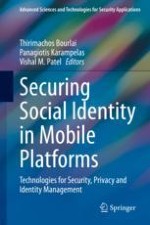2020 | OriginalPaper | Chapter
A Protocol for Decentralized Biometric-Based Self-Sovereign Identity Ecosystem
Authors : Asem Othman, John Callahan
Published in: Securing Social Identity in Mobile Platforms
Publisher: Springer International Publishing
Activate our intelligent search to find suitable subject content or patents.
Select sections of text to find matching patents with Artificial Intelligence. powered by
Select sections of text to find additional relevant content using AI-assisted search. powered by
